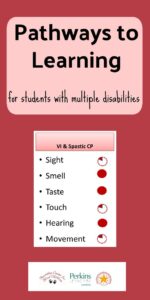Pathways to Learning
A child with special needs is a life-long learner, just like his or her peers. And like his/her peers, he or she will gradually learn according to his/her level of physical, mental and emotional capacity. Learning is therefore restricted only by a lack of learning opportunities in a poor learning environment.
In order for a child with special needs to learn, the adults must create learning environments that will:
- Facilitate the child’s learning at any time;
- Facilitate learning at any developmental level;
- Encourage the learner to explore and experiment actively;
- Enable the learner to repeat his/her activities;
- Enable the learner to be active without interference from others;
- Allow the learner to use previously achieved skills; and
- Enhance the learner’s self-esteem.
What Are the Pathways?
In order to do this the adult must first become aware of the available “pathways to learning” each child possesses. These pathways include:
- Sight
- Smell
- Taste
- Touch
- Hearing
- Movement,
Each child has a unique profile in terms of the best pathways for learning. For example a totally blind child cannot use sight as a learning pathway, but may gain a great deal of information from touch or hearing. In contrast a child with poor visual acuities may still get a great deal of information through vision and be interested in the visual aspects of an environment or activity. Both children, if they have orthopedic or muscular challenges, may not be able to move easily and so may not be able to learn as much through their own movement and actions upon their environment as a child without these challenges.
In the example to the right, a simple graphic shows which senses or learning pathways are available to a child who is visually impaired with spastic cerebral palsy. Sight, touch, and movement are only partially available to him, but smell, taste, and hearing are fully available learning pathways. By examining which pathways are available to an individual, either partially or fully, and creating learning environments that appeal to these pathways, we can overcome one of the number one health risks for a child with special needs — sensory deprivation. Sensory deprivation can lead to secondary disabilities and self-stimulatory behaviors.
It is important to have a good idea which learning pathways are available to an individual when we begin to develop learning environments, select equipment, or create activities.
Patty Obrzut Discusses Pathways to Learning
Description: Dr. Nielsen identifies Pathways to Learning as the five senses and movement. Patty Obrzut gives examples of each and selecting equipment for individual learners with different disabilities.


